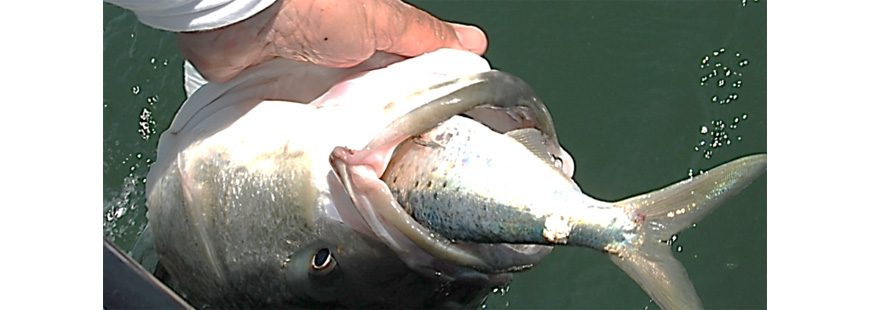Photo: Striped bass w/menhaden, by John McMurray.
Fisheries management is based on a single-species approach. Stock assessments are done, annual catch limits (ACLs) are applied, and we know how many fish can be taken from the resource, leaving enough to produce a stable population for years to come. The single-species approach is effective in many circumstances. In fact, almost 90% of fish stocks that are fished under ACLs are not overfished. However, most of these stocks are predators that are fairly high up on the trophic level. As you work your way down the food pyramid, it becomes extremely difficult to apply a single-species approach. The closer you get to the base, the greater the interdependencies.
We have seen this first hand in the Chesapeake Bay, and it isn’t pretty. The Chesapeake Bay is the number one fish nursery on the East Coast. It is home to a myriad of species, including menhaden, that the rest of the coast depends on. As many of you know, more than 75% of the coast-wide menhaden catch comes from Omega Protein, located in Reedville, Virginia. Omega Protein is incredibly effective at catching these oily little fish, so much so that Reedville is behind only New Bedford, Massachusetts in sheer weight of fish caught in the lower 48. That’s incredible when you realize that New Bedford’s poundage is based off of dozens of species, while Reedville only catches one.
The repercussions of this activity have been far reaching. We’ve been witness to the food web disintegrating slowly over time. There is a definite relationship between striped bass, weakfish, bluefish, and menhaden. The relationship becomes very apparent during the fall. As the water cools, the aquatic biomass of the Atlantic moves south and intercepts all of the juvenile fish leaving the various estuaries. Stripers, blues, and weakfish wait for the juvenile fish to exit and fatten up for the winter. What happens when you remove menhaden from the equation? Well, has anyone seen a weakfish in the last ten years? Me neither. They are essentially disappearing at 11 inches.
Weakies are soft-rayed fish. The juveniles leave the estuaries and become the soup de jour for the mass of predators. Currently, weakfish populations are so low that scientists wonder if there is enough genetic diversity left in the dwindling population for any recovery. But that isn’t even the half of it. When menhaden were at their lowest point several years ago, osprey had the lowest recruitment (juvenile survival) since the DDT days. Striped bass also suffered greatly from a disease called mycobacteriosis. I can’t tell you how sad it is to see a striper covered in red lesions. Some fish are so bad that no angler would consider touching them. Myco is a wasting disease and many fish never recover. At its worst, 70% of striped bass in the Chesapeake Bay had myco. Essentially, stripers and other species aren’t getting enough good food. It takes hundreds of bay anchovy to equal the dietary intake of one adult menhaden.
As I write this, it strikes me as patently absurd that we have to prove that species are interconnected. It’s nature, where everything has a purpose and a function.
We must maintain a large menhaden population to support the entire ecosystem, and, after many years, we have finally come to a crossroads. On November 13 and 14, the Atlantic States Marine Fisheries Commission will vote on Ecological Reference Points for menhaden. In plain speak, menhaden might get managed for their ecological importance rather than as a single species. The document being reviewed is called Amendment 3. The option you want to vote for is “E,” and it is based on common sense. When the draft of Amendment 3 went out for comment, over 25,000 people supported “E” in written comments. A total of 11 comments were received in support of status quo. Nothing is a slam dunk in fisheries management though.
While the final meeting is in the Baltimore area, each state will hold public hearings prior to November. I can’t express how important it is for you to attend these hearings. We have fought this battle for the better part of a decade.
You read posts from the conservation warriors that educate and hopefully motivate you. If you ever felt any level of appreciation for all the good work that others do and you don’t have time for, now’s the time to pay it back. Guys like me, John McMurray, Charles Witek, and scores of others fight the good fight, but we need some backup on this one. Please consider attending your local hearing. Together we will be the difference between a healthy food web and a dwindling resource.


